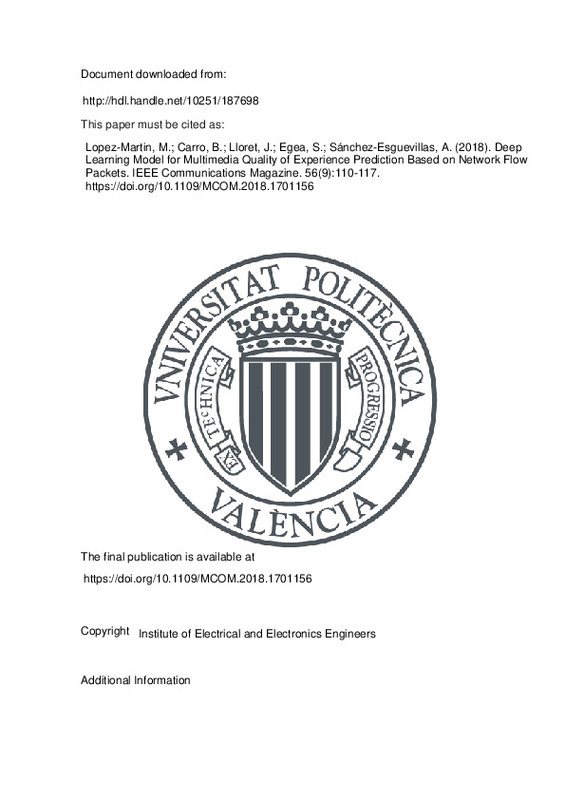JavaScript is disabled for your browser. Some features of this site may not work without it.
Buscar en RiuNet
Listar
Mi cuenta
Estadísticas
Ayuda RiuNet
Admin. UPV
Deep Learning Model for Multimedia Quality of Experience Prediction Based on Network Flow Packets
Mostrar el registro sencillo del ítem
Ficheros en el ítem
| dc.contributor.author | Lopez-Martin, Manuel
|
es_ES |
| dc.contributor.author | Carro, Belén
|
es_ES |
| dc.contributor.author | Lloret, Jaime
|
es_ES |
| dc.contributor.author | Egea, Santiago
|
es_ES |
| dc.contributor.author | Sánchez-Esguevillas, Antonio
|
es_ES |
| dc.date.accessioned | 2022-10-13T18:07:33Z | |
| dc.date.available | 2022-10-13T18:07:33Z | |
| dc.date.issued | 2018-09-16 | es_ES |
| dc.identifier.issn | 0163-6804 | es_ES |
| dc.identifier.uri | http://hdl.handle.net/10251/187698 | |
| dc.description.abstract | [EN] Quality of experience (QoE) is the overall acceptability of an application or service, as perceived subjectively by the end user. In particular, for video quality the QoE is dependent of video transmission parameters. To monitor and control these parameters is critical in modern network management systems, but it would be better to be able to monitor the QoE itself (in terms of both interpretation and accuracy) rather than the parameters on which it depends. In this article we present the first attempt to predict video QoE based on information directly extracted from the network packets using a deep learning model. The QoE detector is based on a binary classifier (good or bad quality) for seven common classes of anomalies when watching videos (blur, ghost, etc.). Our classifier can detect anomalies at the current time instant and predict them at the next immediate instant. This classifier faces two major challenges: first, a highly unbalanced dataset with a low proportion of samples with video anomaly, and second, a small amount of training data, since it must be obtained from individual viewers under a controlled experimental setup. The proposed classifier is based on a combination of a convolutional neural network (CNN), recurrent neural network, and Gaussian process classifier. Image processing, which is the common domain for a CNN, has been expanded to QoE detection. Based on a detailed comparison, the proposed model offers better performance metrics than alternative machine learning algorithms, and can be used as a QoE monitoring function in edge computing | es_ES |
| dc.description.sponsorship | This work has been funded by the Ministerio de Economia y Competitividad del Gobierno de Espana and the Fondo de Desarrollo Regional (FEDER) within the project "Inteligencia distribuida para el control y adaptacion de redes dinamicas definidas por software, Ref: TIN2014-57991-C3-2-P," and also by the Ministerio de Economia y Competitividad in the Programa Estatal de Fomento de la Investigacion Cientifica y Tecnica de Excelencia, Subprograma Estatal de Generacion de Conocimiento with the projects "Distribucion inteligente de servicios multimedia utilizando redes cognitivas adaptativas definidas por software, Ref: TIN2014-57991-C3-1-P" and "Red Cognitiva Definida por Software Para Optimizar y Securizar Trafico de Internet de las Cosas con Informacion Critica, Ref TIN2017-84802-C2-1-P." | es_ES |
| dc.language | Inglés | es_ES |
| dc.publisher | Institute of Electrical and Electronics Engineers | es_ES |
| dc.relation.ispartof | IEEE Communications Magazine | es_ES |
| dc.rights | Reserva de todos los derechos | es_ES |
| dc.subject.classification | INGENIERIA TELEMATICA | es_ES |
| dc.title | Deep Learning Model for Multimedia Quality of Experience Prediction Based on Network Flow Packets | es_ES |
| dc.type | Artículo | es_ES |
| dc.identifier.doi | 10.1109/MCOM.2018.1701156 | es_ES |
| dc.relation.projectID | info:eu-repo/grantAgreement/AEI/Plan Estatal de Investigación Científica y Técnica y de Innovación 2013-2016/TIN2017-84802-C2-1-P/ES/RED COGNITIVA DEFINIDA POR SOFTWARE PARA OPTIMIZAR Y SECURIZAR TRAFICO DE INTERNET DE LAS COSAS CON INFORMACION CRITICA/ | es_ES |
| dc.relation.projectID | info:eu-repo/grantAgreement/MINECO//TIN2014-57991-C3-1-P/ES/DISTRIBUCION INTELIGENTE DE SERVICIOS MULTIMEDIA UTILIZANDO REDES COGNITIVAS ADAPTATIVAS DEFINIDAS POR SOFTWARE/ | es_ES |
| dc.relation.projectID | info:eu-repo/grantAgreement/MINECO//TIN2014-57991-C3-2-P/ES/INTELIGENCIA DISTRIBUIDA PARA EL CONTROL Y ADAPTACION DE REDES DINAMICAS DEFINIDAS POR SOFTWARE/ | es_ES |
| dc.rights.accessRights | Abierto | es_ES |
| dc.contributor.affiliation | Universitat Politècnica de València. Departamento de Comunicaciones - Departament de Comunicacions | es_ES |
| dc.description.bibliographicCitation | Lopez-Martin, M.; Carro, B.; Lloret, J.; Egea, S.; Sánchez-Esguevillas, A. (2018). Deep Learning Model for Multimedia Quality of Experience Prediction Based on Network Flow Packets. IEEE Communications Magazine. 56(9):110-117. https://doi.org/10.1109/MCOM.2018.1701156 | es_ES |
| dc.description.accrualMethod | S | es_ES |
| dc.relation.publisherversion | https://doi.org/10.1109/MCOM.2018.1701156 | es_ES |
| dc.description.upvformatpinicio | 110 | es_ES |
| dc.description.upvformatpfin | 117 | es_ES |
| dc.type.version | info:eu-repo/semantics/publishedVersion | es_ES |
| dc.description.volume | 56 | es_ES |
| dc.description.issue | 9 | es_ES |
| dc.relation.pasarela | S\472765 | es_ES |
| dc.contributor.funder | AGENCIA ESTATAL DE INVESTIGACION | es_ES |
| dc.contributor.funder | European Regional Development Fund | es_ES |
| dc.contributor.funder | Ministerio de Economía y Competitividad | es_ES |
| dc.contributor.funder | MINISTERIO DE ASUNTOS ECONOMICOS Y TRANSFORMACION DIGITAL | es_ES |







![[Cerrado]](/themes/UPV/images/candado.png)

